Introduction
Among the
most important environmental problems of the present day, the issue
of protecting natural sources of water supply is of paramount
importance. The discharging of raw and insufficiently treated
wastewater in the surface water reservoirs constantly worsens their
condition; these sources of pollution, as a rule, contain compounds
of nitrogen and phosphorus. Therefore, deep purification of
wastewater is one of the most important problems for today.
The accumulated experience and
scientific research of many generations of specialists prove the
priority of biological methods of purification. Today, the majority
of wastewater, which is discharged in a centralized way, is cleared
at aeration stations in aerotanks [1, 2, 4, 5, 12]. However, the
existing conventional biological purification technology is
characterized by inadequate efficiency (especially for the removal
of phosphorus compounds) and is not always able to meet the set
norms [3, 7, 14, 16, 19, 23].
Therefore, in wastewater
treatment plants, where biological treatment of effluent is carried
out according to the traditional scheme, the important practical
tasks are the issues of improvement of existing technologies of
wastewater treatment on the basis of these structures, increase of
their efficiency.
In general, the following
solutions are used to improve the efficiency of aerotanks: the
creation of sites with aerobic and anaerobic conditions of oxidation
[2, 13, 21], the use of uneven dispersed effluent intake [2], the
supply of technical oxygen [2, 15], the addition of reagent
preparations [2, 15], etc. It is clear that the improvement of
structures and technologies is delayed by economic factors. Also
currently, the widely used effluent clarification method has become
the process of simultaneous removal of organic pollutants (OP) and
nitrogen by suspended and attached biocenosis [20, 22]. By their
activity immobilized biocenosis considerably exceed the oxidation
capacity of suspended active sludge.
In this case, the loading
elements (nozzles, screens, etc.) can be located throughout the
volume of the aerotanks or more densely and compactly only in its
individual sections.
However, the possibility of
evaluating the efficiency of aerotank due to add-on elements with
attached biocenosis (biofilm) requires more complete and advanced
mathematical models. Models that will take into account the
processes of simultaneous oxidation of OP by suspended and attached
biocenosis will allow to reasonably estimate the influence of
various factors of purification in aerotanks. These processes are
associated with the formation of a biofilm of different thickness
and structure on the surface of the additional loading (screen) in
the aerotank volume [13, 21].
The parameters of wastewater
treatment, determined by numerical methods, taking into account the
influence of various purification factors will give an opportunity
to obtain reliable results. Based on the results obtained, it is
possible to evaluate the effectiveness of the aerotanks through the
introduction of additional elements with the attached biocenosis
(biofilm).
Purpose
The
main purpose is to carry out calculations
and obtain a comparative assessment of the efficiency of
complete-mix aerotanks
and continuous-flow aeration tanks. Herewith wastewater is treated
due to the additional arrangement in their volume of loading with
the attached biocenosis (biomass) in the form of a biofilm with a
high concentration of microorganisms.
To achieve
this purpose, the following tasks need to be addressed:
– Provide
calculation
dependencies and
mathematical
models that
allow estimating
the influence
of various
factors on
the simultaneous
removal of
organic
pollutants (OP)
with suspended
and attached
biocenosis in
aerotanks of
various
structures,
namely in
complete-mix
aerotanks and
continuous-flow aeration tanks;
– On
the basis
of the
proposed models
and methods
of calculation,
to conduct
an analysis
and evaluation
of the
influence of
the main
factors, to
identify the
parameters of
supply of
the required
amount of
oxygen to
the place
of reaction
and the
disposal of
OP;
– To
consider the
specific
examples for
different
process flow
schemes of
the location
of the
attached biomass
reactor and
to provide
comparative
results of
studies of
simultaneous OP
purification;
– To
substantiate the increased efficiency of effluent clarification due
to the arrangement of the attached biocenosis in the volume of the
aerotanks.
Methodology
Mathematical
models were constructed and methods for calculating the parameters
of purification [6, 7, 11, 17, 18] were developed for the estimation
and analysis of the simultaneous removal of organic pollutants (OP)
with suspended and attached biocenosis in aerotanks of various
structures. In this case, for various hydrodynamic schemes of
aerotanks, namely complete-mix aerotanks and continuous-flow
aeration tanks. The specific examples
showed and substantiated a significant increase in the efficiency of
purification due to the add-on attached biocenosis.
First, let
us consider the most advisable from the practical point of view
technological scheme of a complete-mix aerotank, which consists of
two parts (reactors 1 and 2) [7]. In
reactor 1, the
OP is
removed only
due to
the suspended
biocenosis
(active sludge),
that is,
it works
as an
ordinary
complete-mix
aerotank. In
the second part (reactor 2), the OP removal occurs mainly by the
attached biocenosis, which is formed at the add-on load, with the
possible consideration, if necessary, of the action of the active
sludge in the reactor 2. It is believed that the biochemical
oxidation process is adequately provided with oxygen, that is, the
flow of oxygen will not limit the kinetics of oxidation of both the
suspended and attached biocenosis. Let us consider also the most
widespread case in which the removal of OP by an active sludge
occurs by
a zero-order reaction, and in a biofilm – by the
first-order reaction. Then, according to [7], to determine the
concentration of OP at the output from the 2nd reactor (of the
aerotank) La2,
the following general dependence is proposed
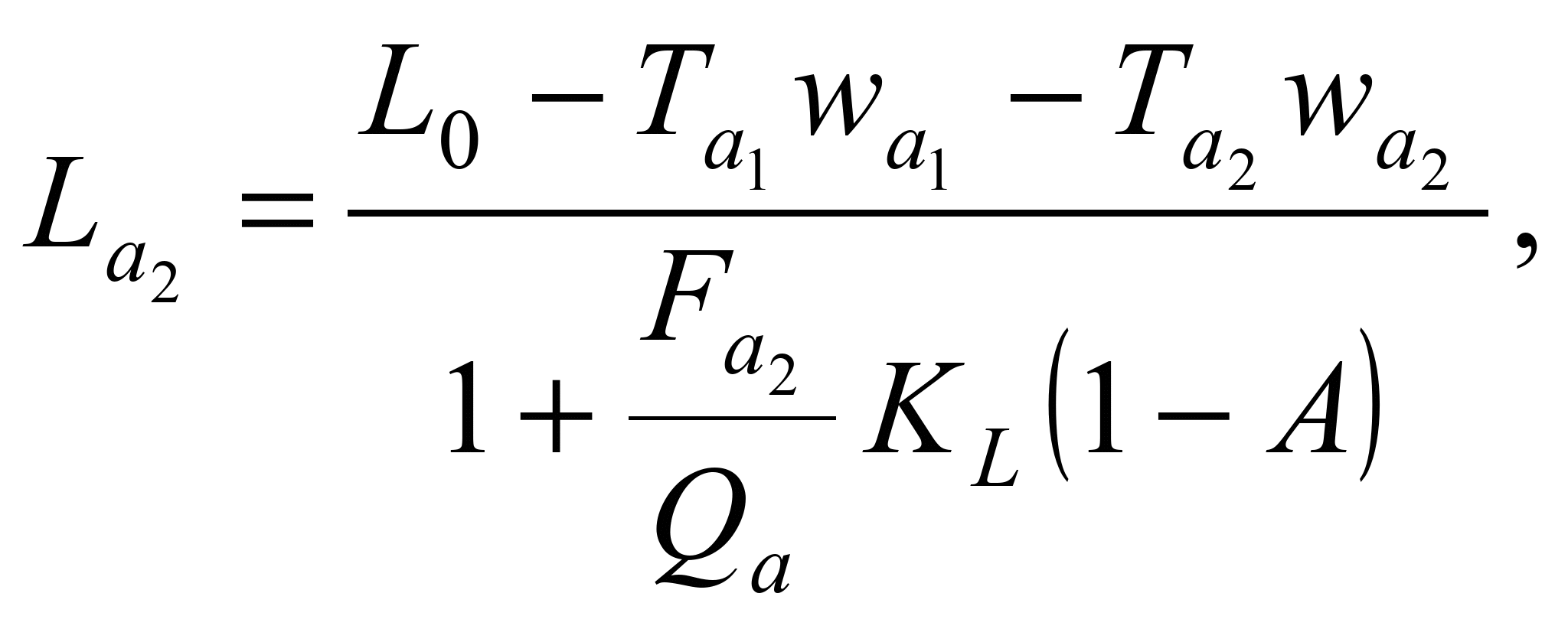 (1)
(1)
where

 (2)
(2)
For the 1st
reactor, the volume of the liquid is assumed to be equal to the
reactor volume
 .
For reactor
2 it is
necessary to
take into
account the
volume loaded
with biofilm
.
For reactor
2 it is
necessary to
take into
account the
volume loaded
with biofilm
 ,
therefore we
have
,
therefore we
have
 . (3)
. (3)
The specific loading area with
the biofilm in the reactor 2 is determined by the formula
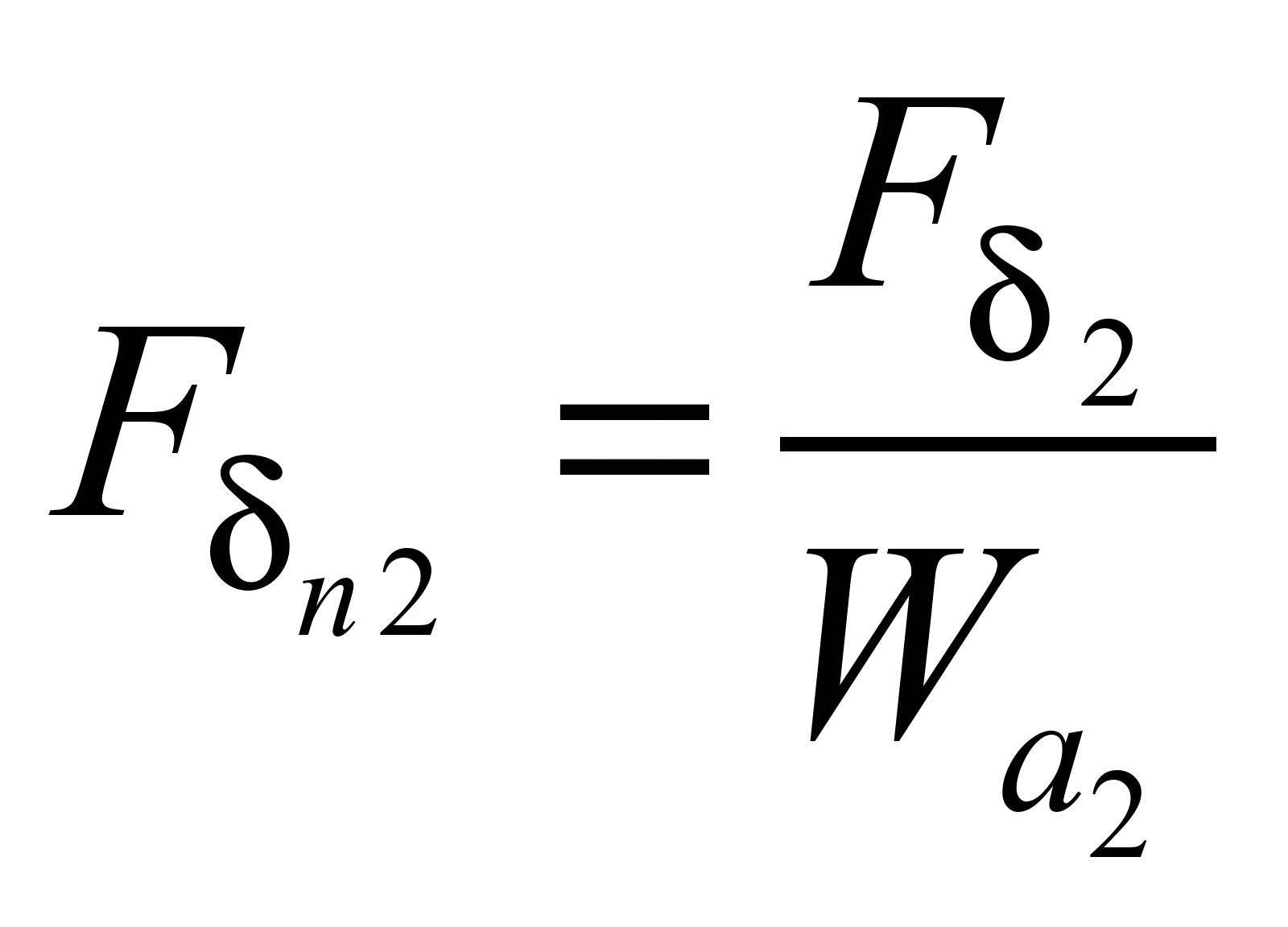 , (4)
, (4)
where
 is the total surface area of
loading (biofilm) in
reactor 2 of volume
is the total surface area of
loading (biofilm) in
reactor 2 of volume
 .
.
Recommendations
for determining the parameter
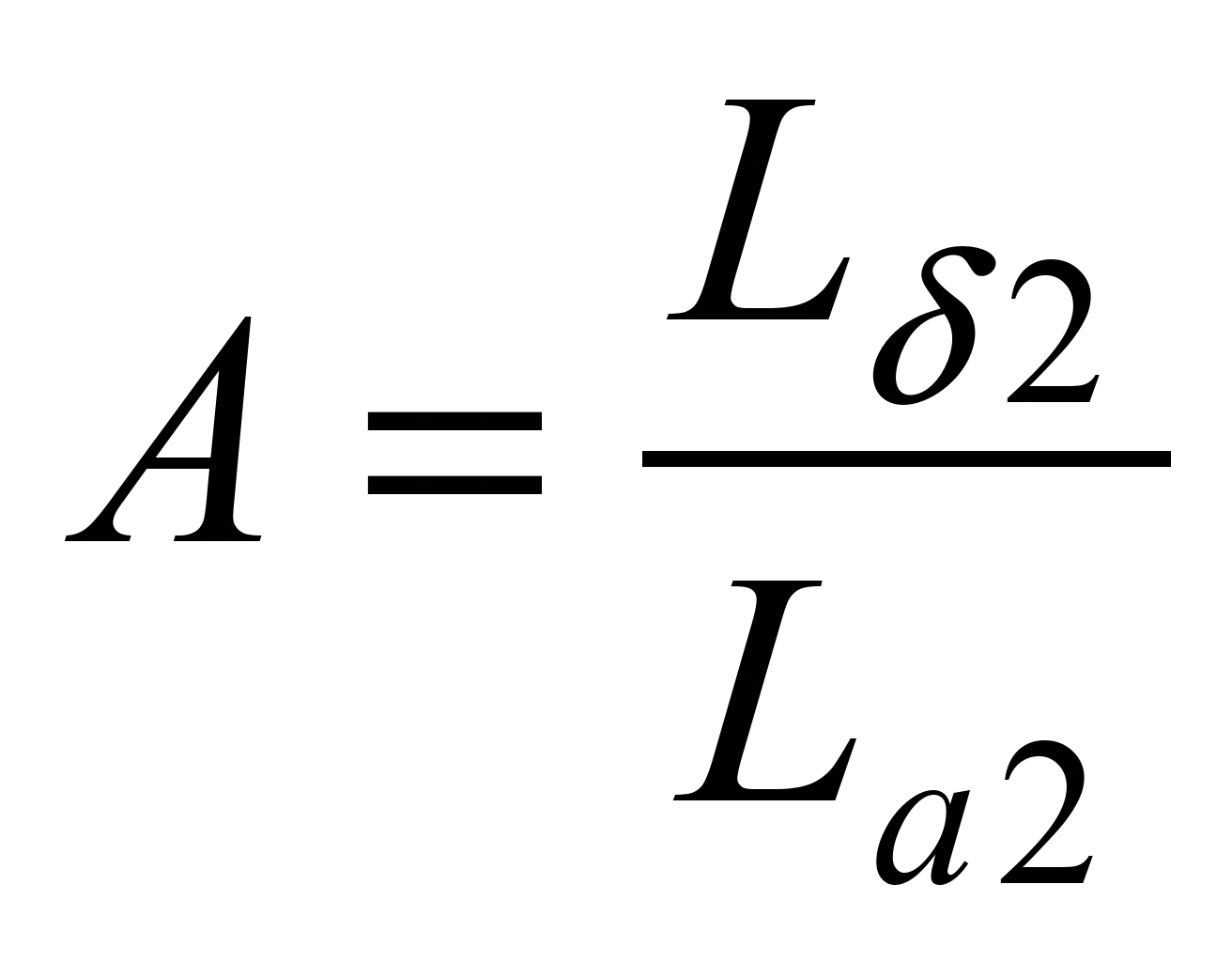 under the assumption that the reaction
rate in the biofilm is taken of the first order, are given in the
papers [7, 9]. Here
under the assumption that the reaction
rate in the biofilm is taken of the first order, are given in the
papers [7, 9]. Here
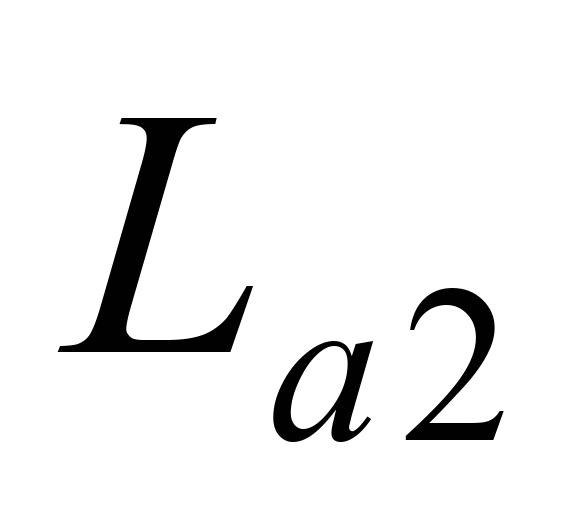 and
and
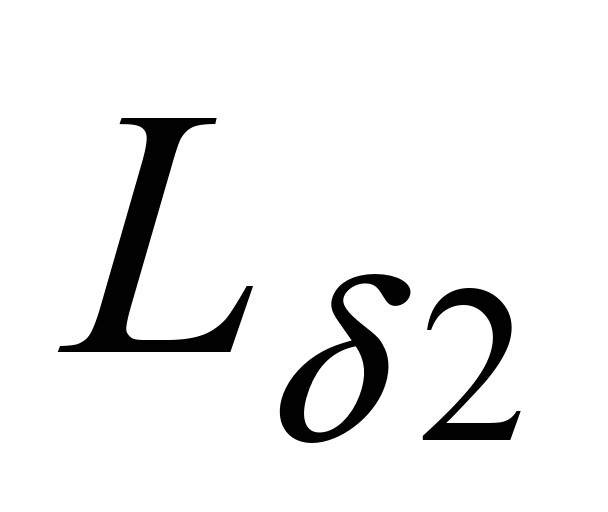 are the concentrations of OP in the
reactor 2 and on the surface of the biofilm.
are the concentrations of OP in the
reactor 2 and on the surface of the biofilm.
For further analysis, the
dependence is represented in the form
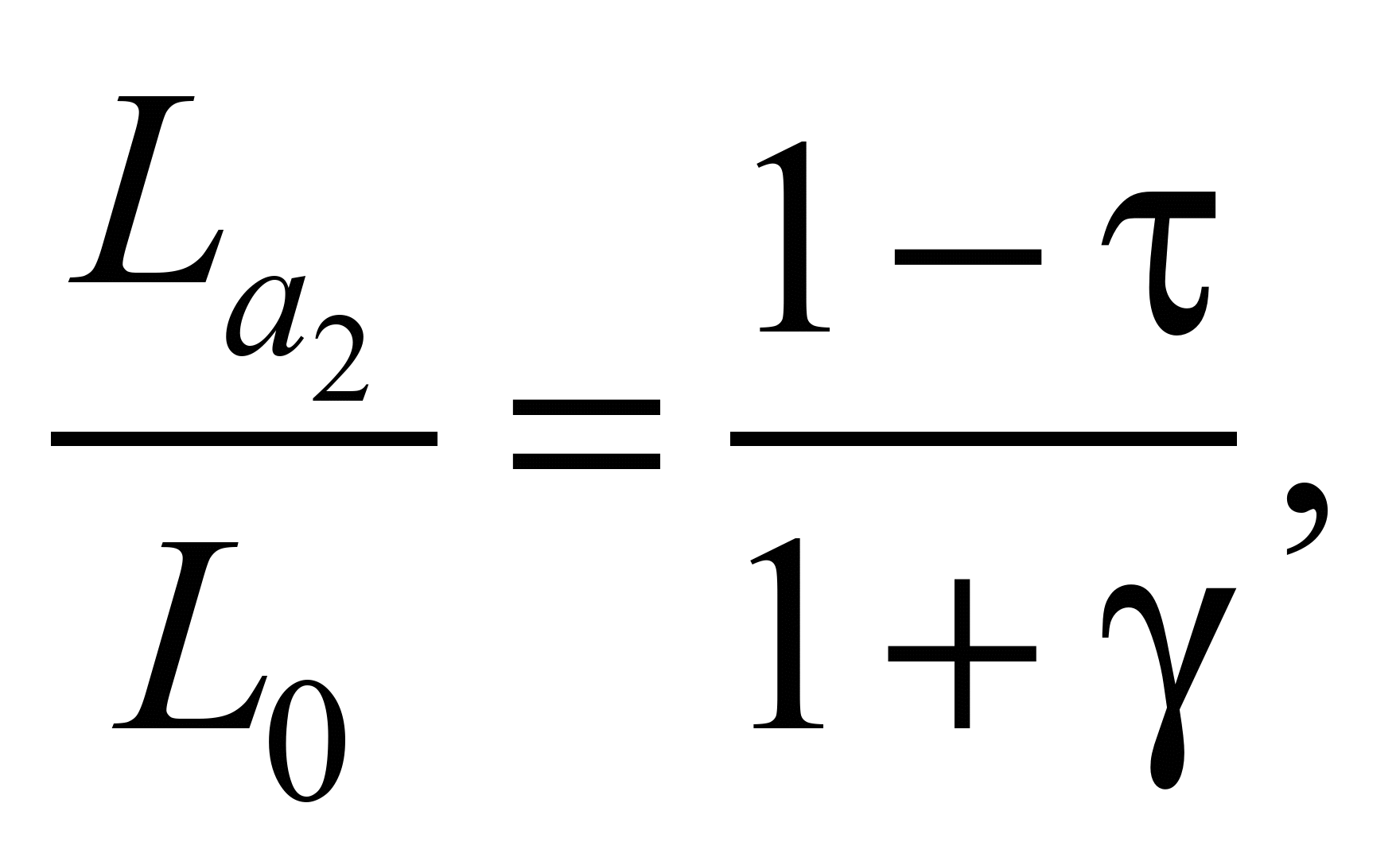 (5)
(5)
where
 (6)
(6)
Fig.
1 shows the
graphs of
the function
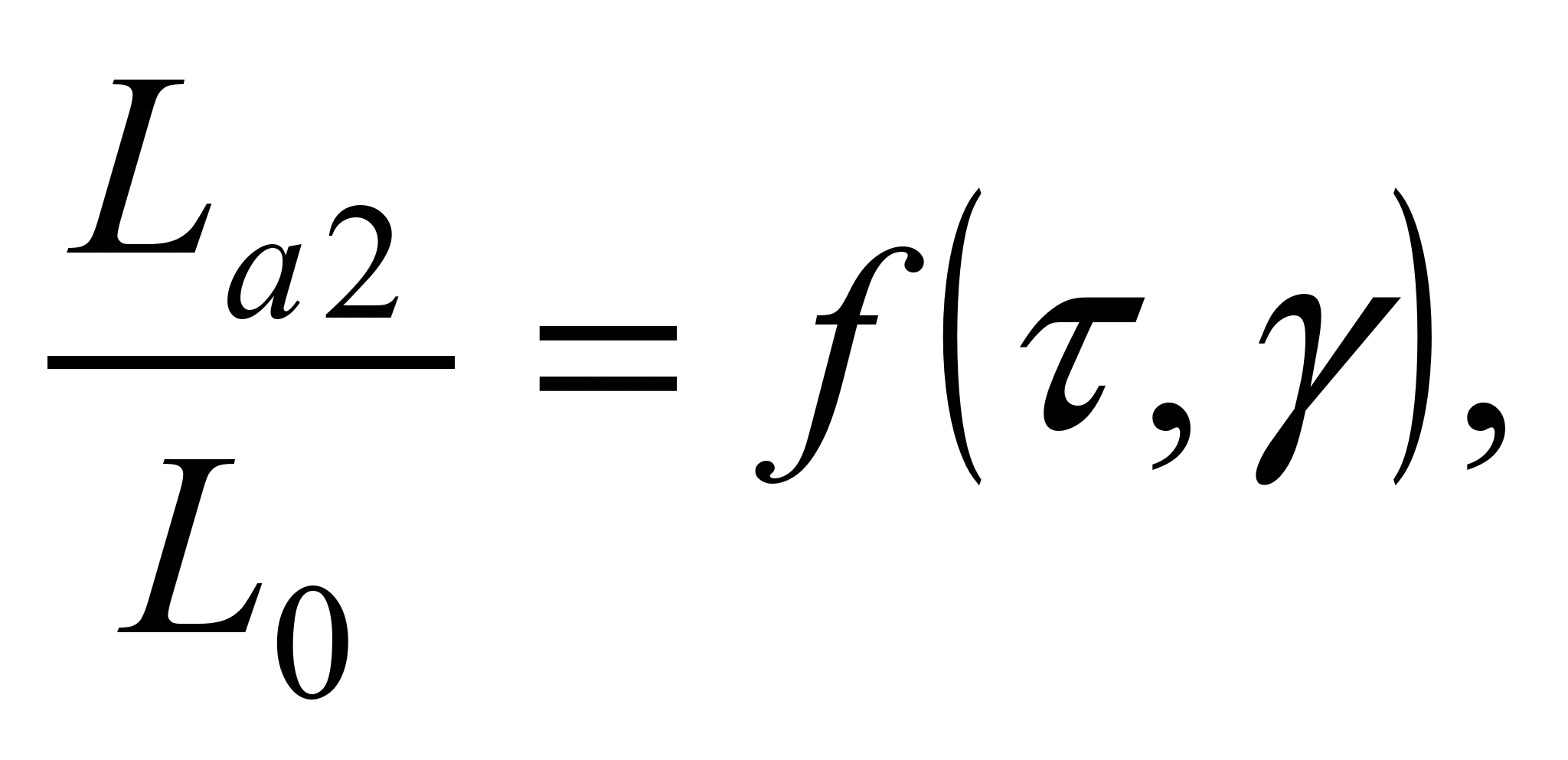 constructed according to the dependence
(5). It is assumed that the volumes of the first and second reactors
coincide
constructed according to the dependence
(5). It is assumed that the volumes of the first and second reactors
coincide
 and that
and that
 .
The results
presented in
Fig. 1 show
that
post-treatment
by the
attached biomass
can
significantly
improve the
quality of
wastewater
treatment.
However, as shown by Fig. 2, with the
increase of the parameter γ, which depends on the flow N and mainly
on the specific loading area
.
The results
presented in
Fig. 1 show
that
post-treatment
by the
attached biomass
can
significantly
improve the
quality of
wastewater
treatment.
However, as shown by Fig. 2, with the
increase of the parameter γ, which depends on the flow N and mainly
on the specific loading area
 ,
that is, on the load element density, this
improvement is significantly slowed down. Therefore, in this case,
as in other process flow schemes of aerotanks with attached
biocenosis, an important issue is the choice of the most appropriate
loading area
,
that is, on the load element density, this
improvement is significantly slowed down. Therefore, in this case,
as in other process flow schemes of aerotanks with attached
biocenosis, an important issue is the choice of the most appropriate
loading area
 based on the additional analysis.
based on the additional analysis.
Fig.
3 shows the
graphs of
the function
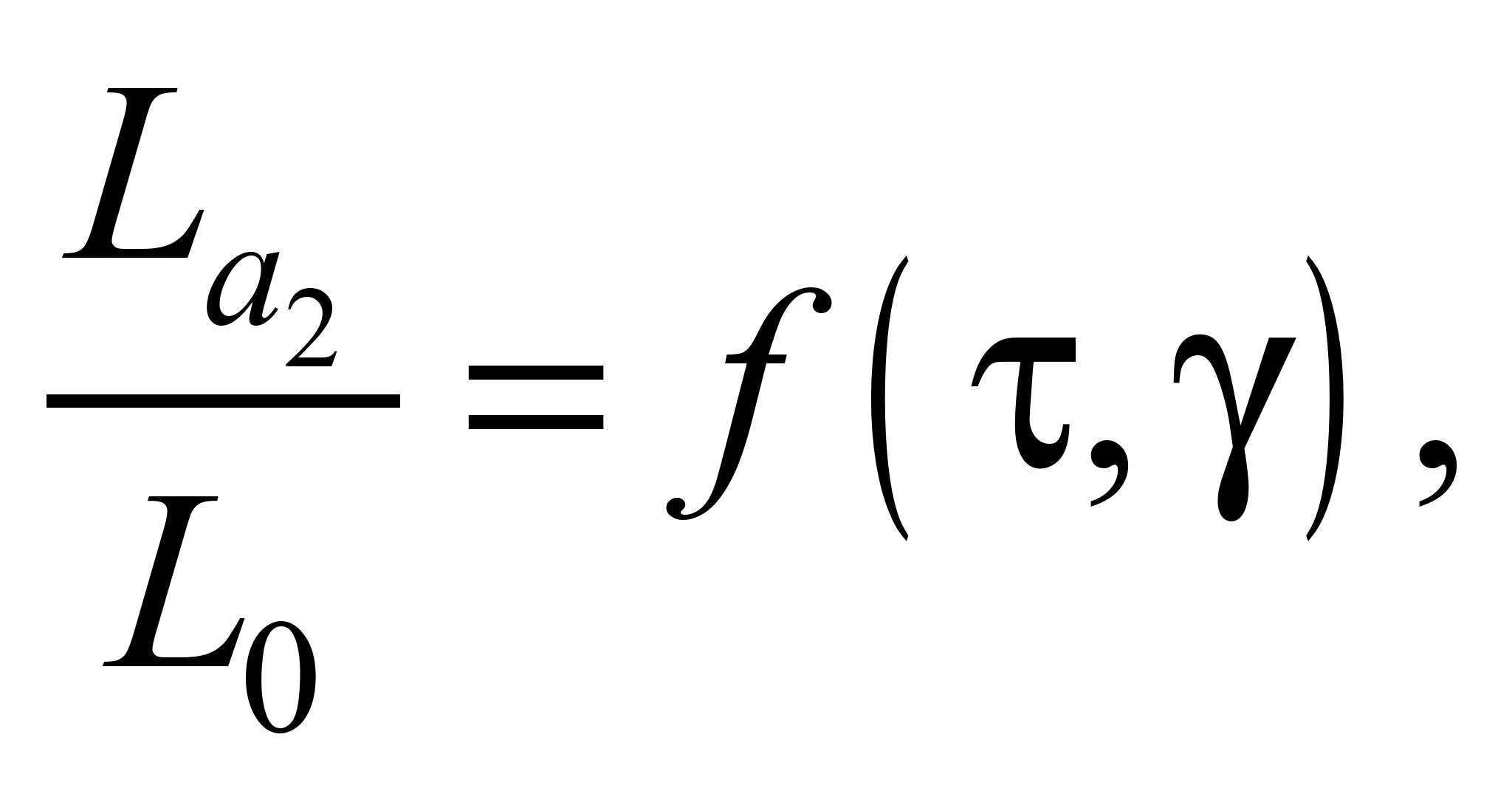 constructed
under the
condition that
the
clarification in
the second
reactor due
to the
suspended
biocenosis
(active sludge)
can be
neglected, i.e.
constructed
under the
condition that
the
clarification in
the second
reactor due
to the
suspended
biocenosis
(active sludge)
can be
neglected, i.e.
 .
.
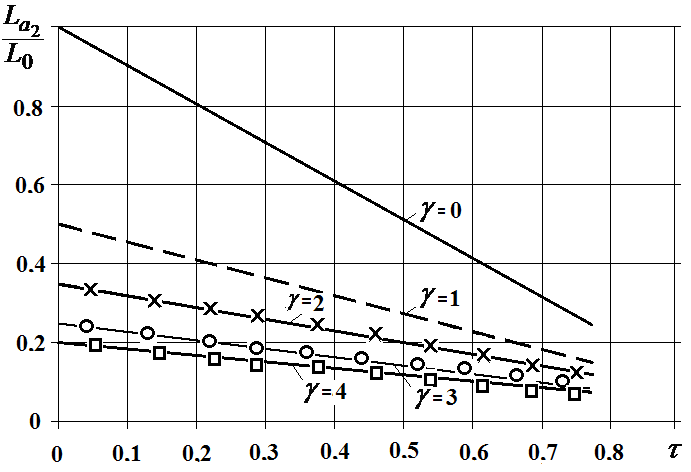
Fig. 1
Dependency graph
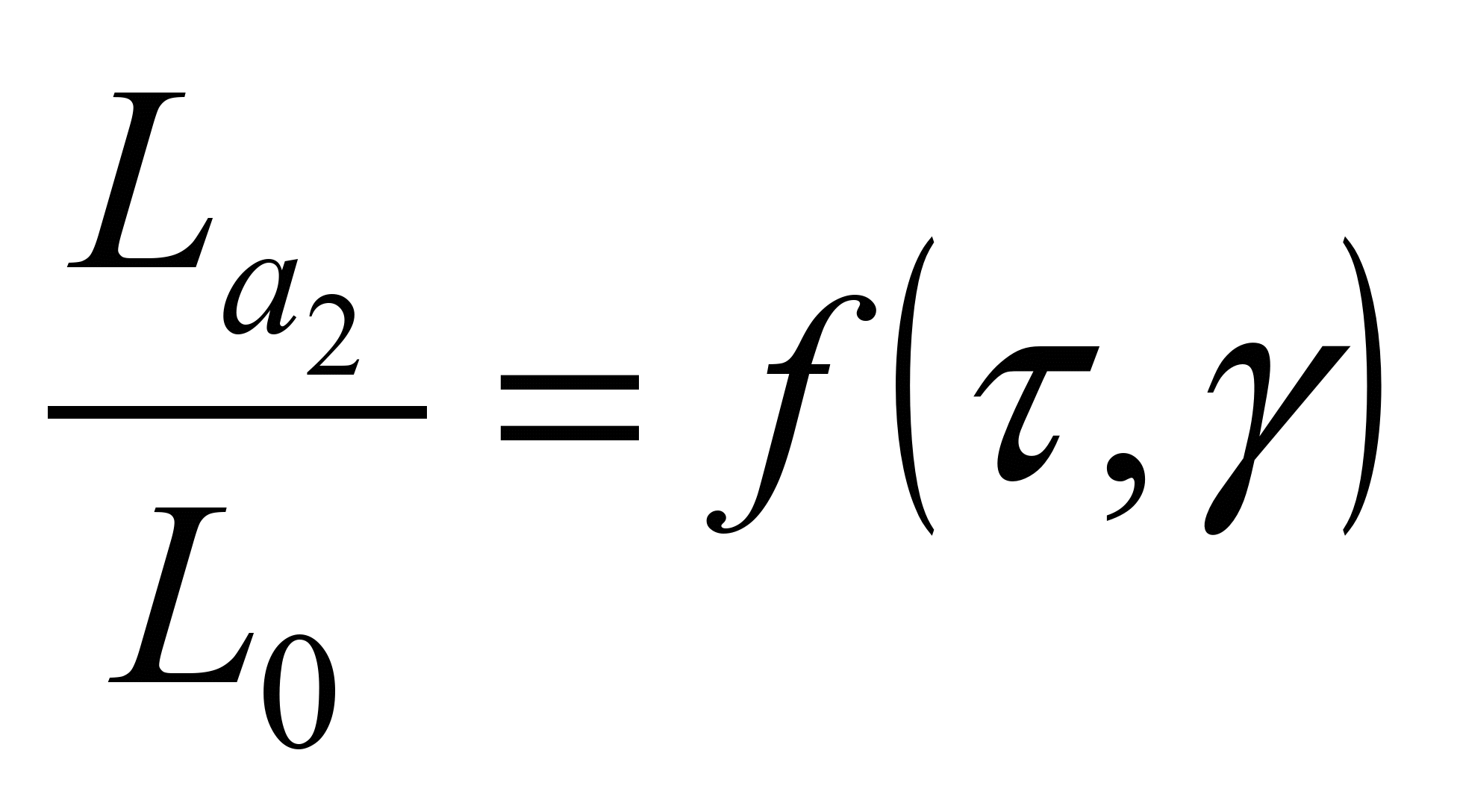
As can be seen from the data in
Fig. 1 and Fig. 3 the active sludge in the second reactor with the
same values of the parameter τ does not significantly affect the
overall clarification effect. However, clarification in the free
volume of the 2nd reactor allows for some increase in the value of
the parameter τ, and, accordingly, the quality of the removal of
organic pollutants.
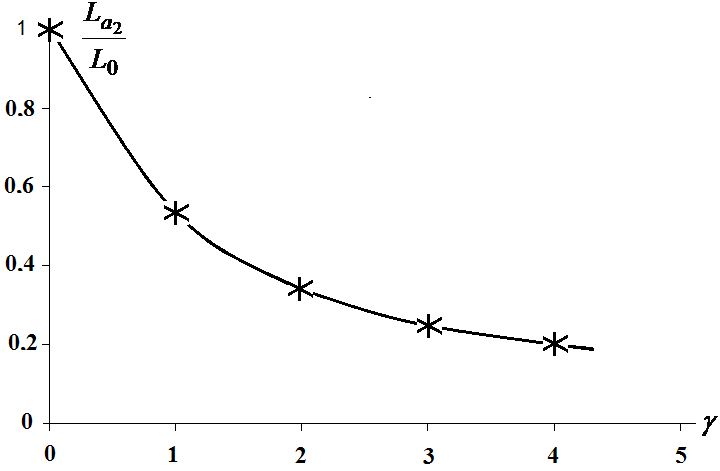
Fig.
2. Dependency graph
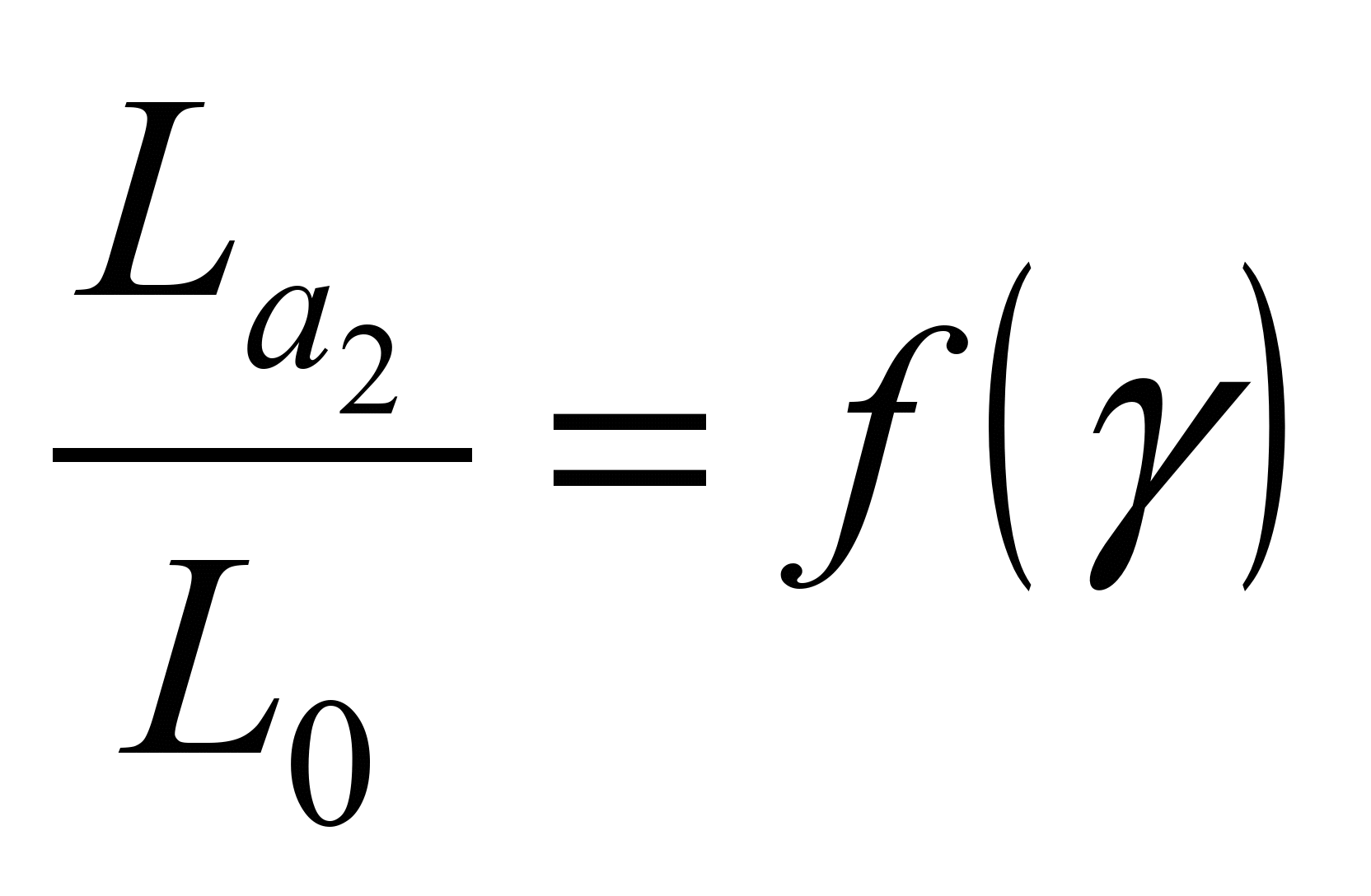 with
with

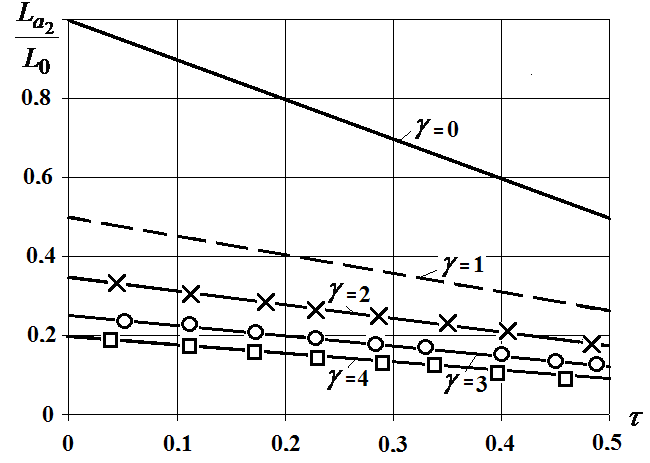
Fig.
3. Dependency graph

The
paper [10 (Fig.
2, 3)] presents the comparative
results of
the studies of
simultaneous OP
clarification in
complete-mix aerotank,
in which
the elements of
additional
loading are
evenly arranged.
When
constructing
these graphs,
the dependence
(5) is used,
in which
the parameters
τ and
γ are
taken in
accordance with
the adopted
process flow
scheme of
the complete-mix
aerotank,
namely:

 . (7)
. (7)
Fδl
is the
total area
of loading
elements in
the complete-mix
aerotank with
length l
and volume
Wal.
According to [10 (Fig. 2, 3)], only at
significant values of the parameter τ and minor values of γ one
should also take into account the removal of OP due to the active
sludge.
The obtained dependencies and
performed calculations allow substantiating the increase in
efficiency of the aerotank using the arrangement of loading elements
with the attached biocenosis in the second half of its volume.
The works
[7, 10] present theoretical studies and methods for calculating the
parameters of biological wastewater treatment from organic
pollutants (OP) in continuous-flow aeration tanks with simulatneous
purification of suspended and attached biocenosis. To evaluate the
efficiency of such aerotanks, let us consider the scheme of their
work with the suspended and attached biocenosis when the loading
elements (nozzles, screens, etc.) are evenly spaced along the entire
length l [10].
As
a result
of the
theoretical
studies carried
out under
the condition
that the
removal of
the OP
by the
suspended and
attached
biocenosis
occurs by
the first-order
reaction, the
following
dependence is
obtained to
determine the
change in
the
concentration of
La
along the
aerotank X
 (8)
(8)
 , (9)
, (9)
where


 is
the loading
surface area
(biofilm) per
unit length
of aerotank
is
the loading
surface area
(biofilm) per
unit length
of aerotank
 (m),
(m),
 – coefficient
of mass
transfer in
a liquid
film (m/h),
– coefficient
of mass
transfer in
a liquid
film (m/h),
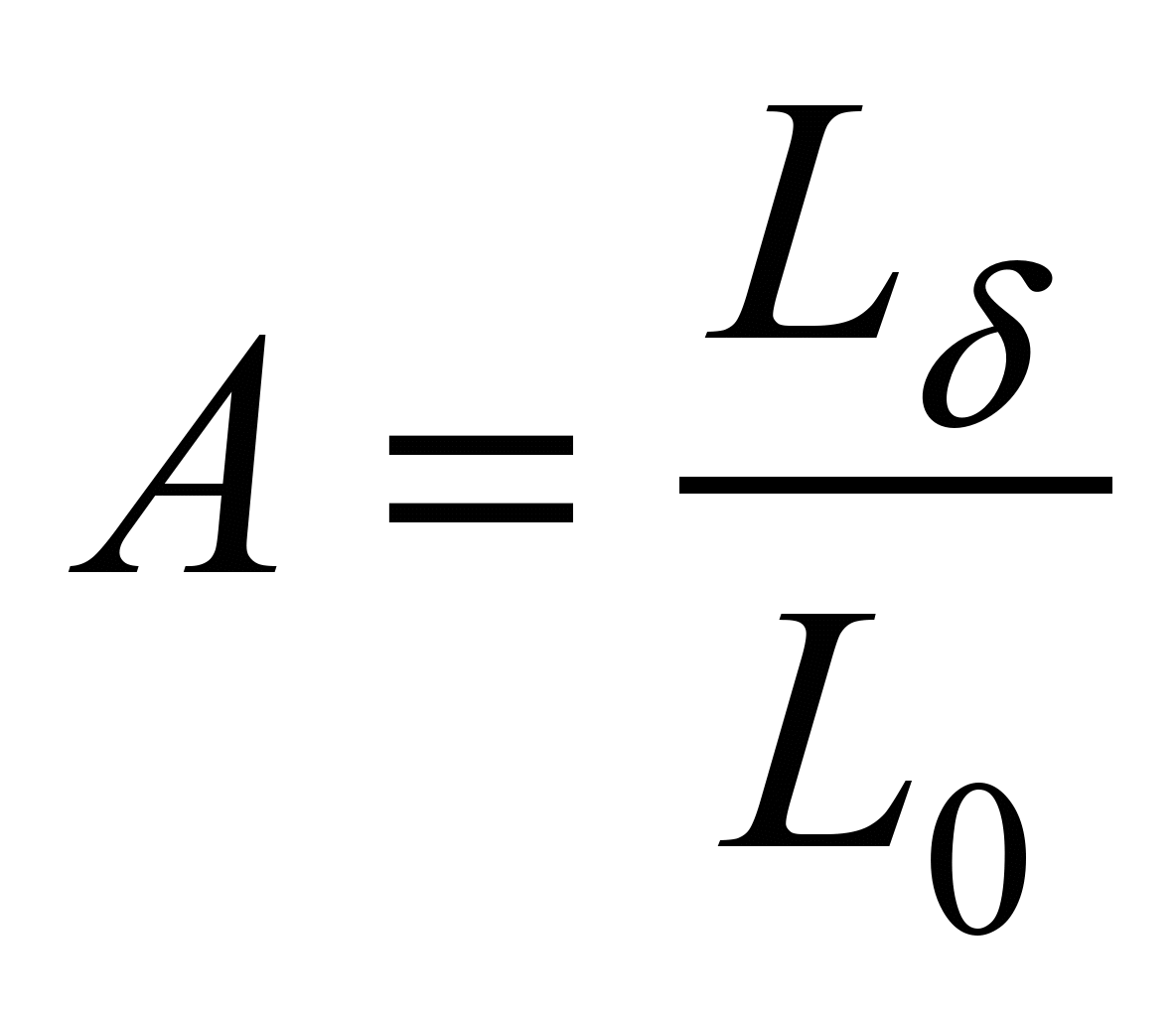 is the
biofilm
parameter
determined
according to
the
recommendations
given in
the papers
[7, 9].
is the
biofilm
parameter
determined
according to
the
recommendations
given in
the papers
[7, 9].
At the exit of the aerotank we
have

 (10)
(10)
In
order to
carry out
further analysis
and obtain
comparative
estimates of
the influence
of various
factors on
the
clarification
processes in
this case,
we represent
the dependence
(10) in the
form
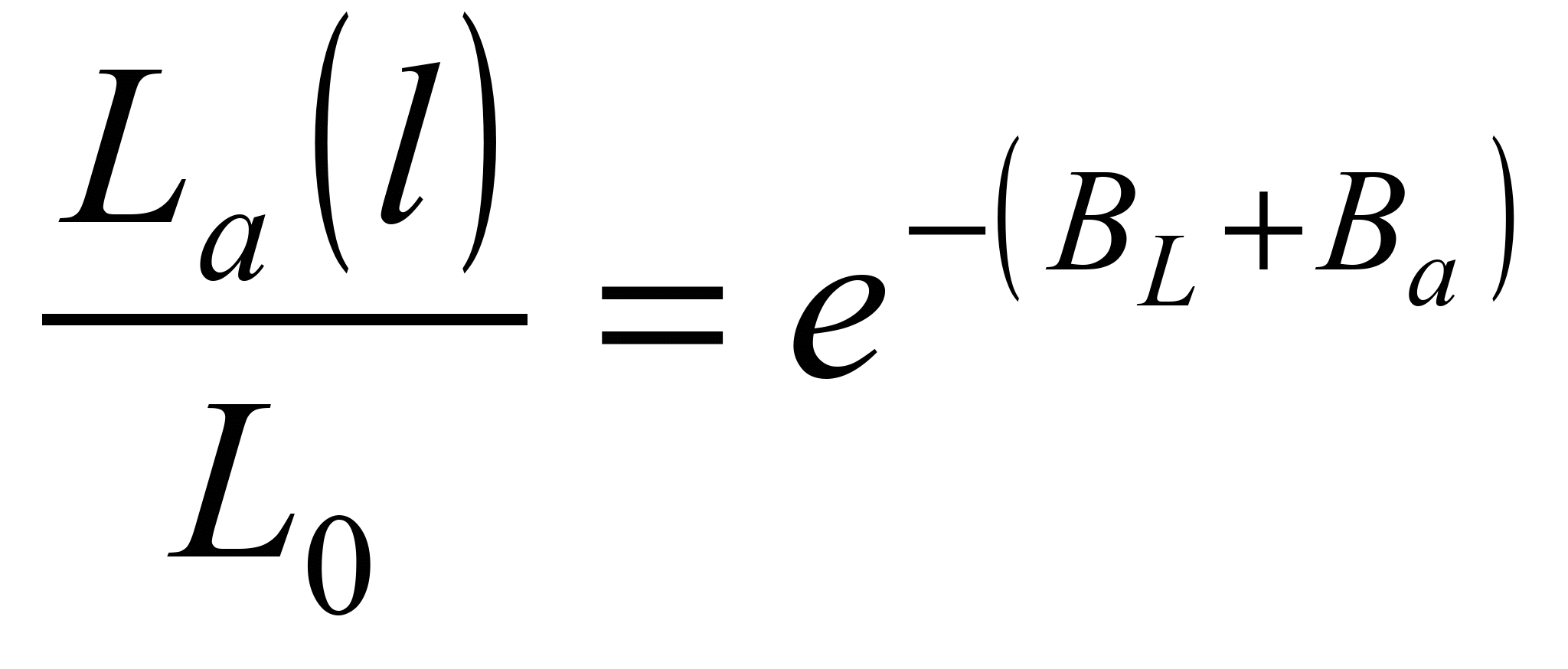 , (11)
, (11)
where

Thus,
at
 the removal
of OP
in aerotanks
occurs only
at the
expense of
suspended
biocenosis
(active sludge),
and at
the removal
of OP
in aerotanks
occurs only
at the
expense of
suspended
biocenosis
(active sludge),
and at
 – only at the expense of the attached
biocenosis (biofilm).
– only at the expense of the attached
biocenosis (biofilm).
Based on the
dependence (11), we built the calculated graphs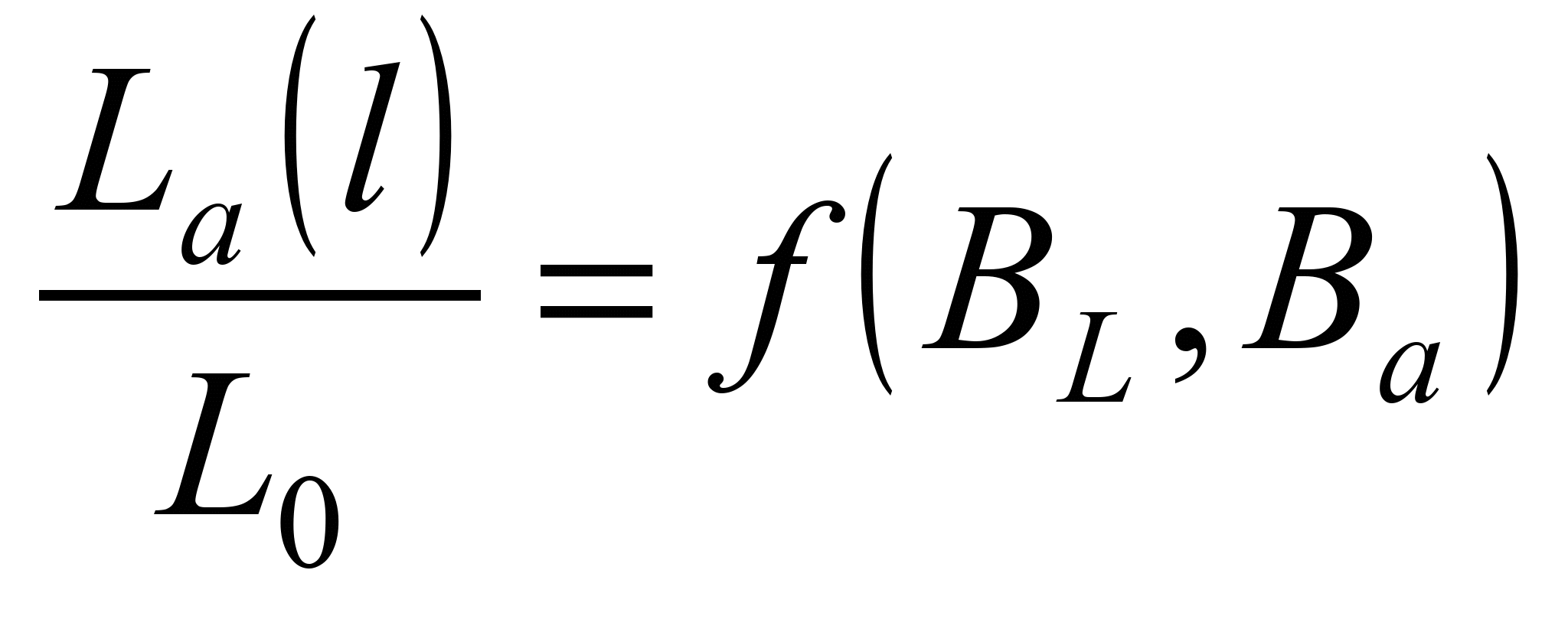 ,
presented in
work [8 (Fig. 3)] and in Fig. 4
,
presented in
work [8 (Fig. 3)] and in Fig. 4
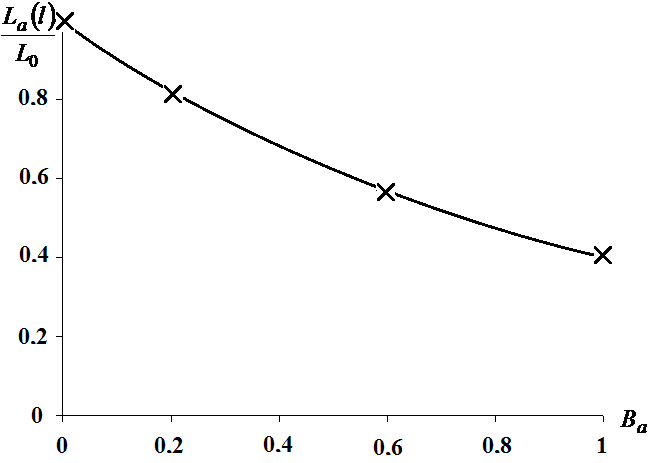
Fig.
4. Dependence graph
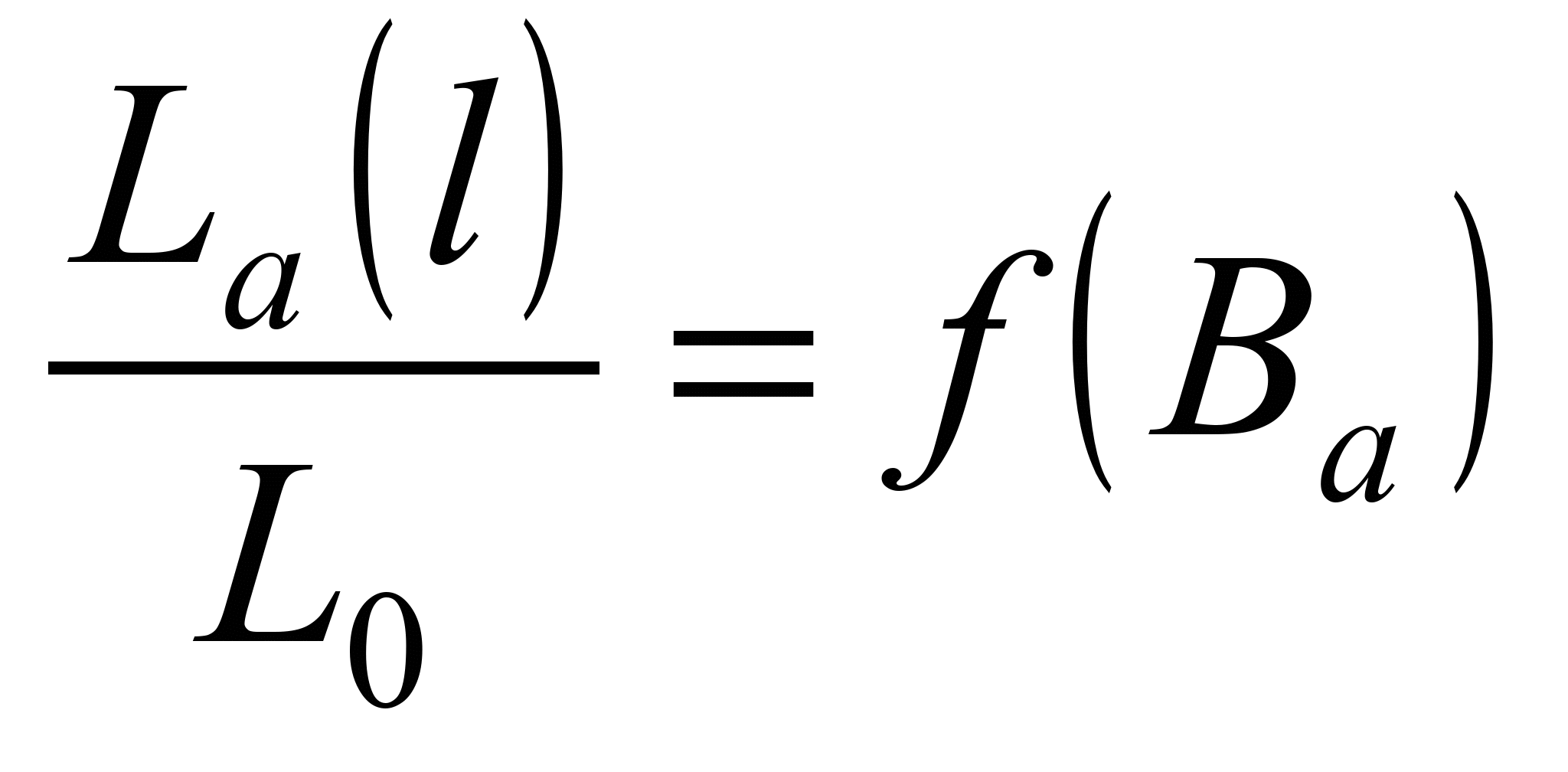
with

The results
of the calculations presented in [8 (Fig. 3)] and in Fig. 4 show
that the additional introduction into the aerotank
of loading with the attached biocenosis
(biofilm) allows to significantly improve the work of the
continuous-flow aeration tank, especially with BL
<
1.
The
work [13]
presents an
experimental
evaluation of
the efficiency
(EF) of
the complete-mix
aerotank due
to add-on
plastic screens,
the results
of which
at
 ml/min,
ml/min,
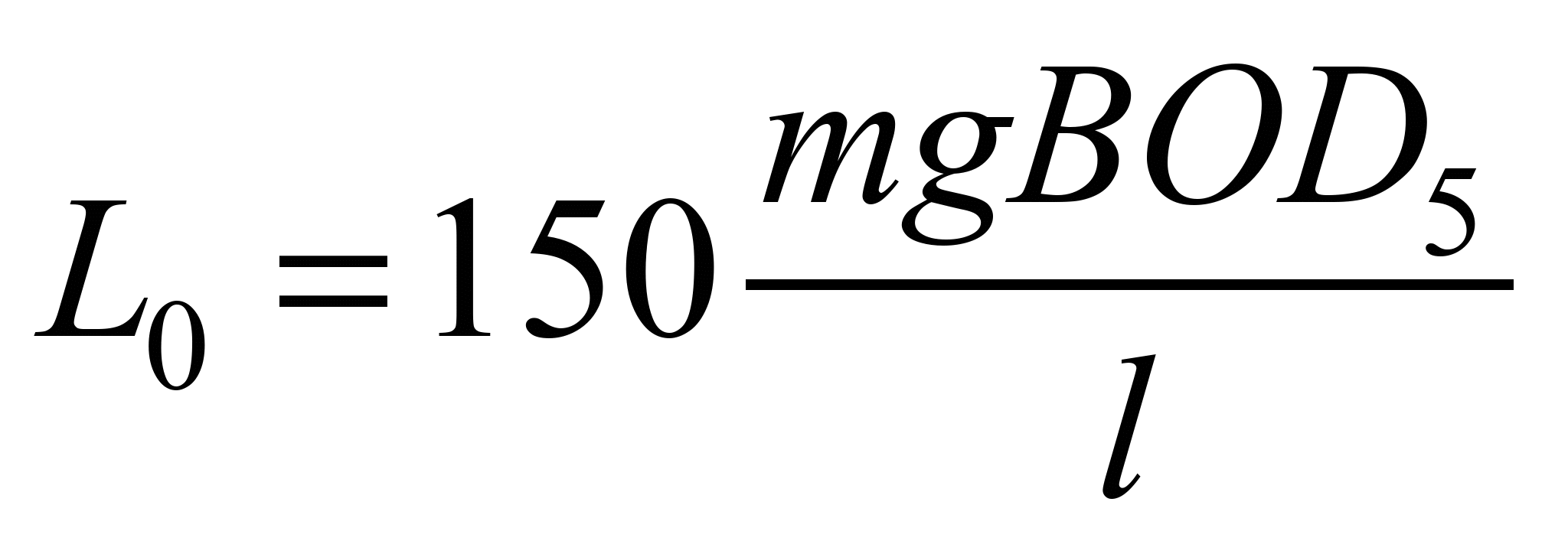 are given
in Table
1.
are given
in Table
1.
The
Table 1 shows
a significant
increase in
EF, a
decrease in
La
when using 6 screens and a gradual
increase in efficiency with increasing number of screens. In this
case, the total increase in efficiency is 25%. As noted earlier in
Fig. 2, 3 and in [10 (Fig. 2)], the intensity of the increase in
efficiency is stabilized upon achievement of the minimum
concentration of pollutants at the output
La
.
Table
1
Experimental
EF evaluation of OP removal
in aerotank
|
Loading
|
Relative
EF in%
|
Total
EF in%
|
Intensity
of EF in%,
|
 ,
mg/l at the output ,
mg/l at the output
|
|
0 screens
6 screens
12 screens
18 screens
24
screens
|
0
25
50
75
100
|
72.50
90.00
95.00
96.50
97.50
|
–
17.50
22.50
23.75
25.00
|
44
16
8
6
4
|
Findings
The comparative calculations on
the presented dependencies make it possible to estimate the
intensity of increasing the clarification efficiency in aerotanks
due to additional elements with attached biocenosis. The constructed
models take into account the special features of the intake of
organic pollutants and oxygen in a biofilm, its parameters, as well
as the velocity of kinetic reactions with the simultaneous removal
of organic contamination by suspended and attached biocenosis.
Implementation of the
calculation methods for the proposed dependencies allows more fully
and reasonably to consider the important processes of wastewater
treatment, which occur with the additional involvement of the
attached biocenosis. These processes significantly affect both the
disposal of OP and the efficiency of aerotanks.
Originality
and practical value
As part of the study described
in this article, it is proposed to increase the efficiency of the
aerotanks by allotting its part for additional loading with attached
biocenosis. In this part there is simultaneous oxidation of organic
pollutants with active sludge and biofilm. The mathematical model
describing this process is presented. There are carried out
calculations, performed comparative evaluation of the unit
efficiency, depending on the degree of influence of the additional
loading. Such an evaluation allows us to justify the rational
parameters of the biological treatment unit of improved design. This
means that the obtained scientific result in the form of the results
of calculations based on the mathematical model of biological
oxidation of organic pollutants by suspended and attached
biocenosis, including an assessment of the influence of these
components on the purification efficiency, is interesting from a
theoretical point of view. From the practical point of view, the
conducted researches allow to justify the use of additional loading
with attached microorganisms in order to improve the quality of
removal of organic pollutants in aerotanks.
Conclusions
The results obtained in the
article give grounds for asserting the possibility of introducing
into the actual technological process of wastewater treatment the
use of attached biocenosis in aerotanks, which will allow getting
effluent at the output from the facilities with a concentration of
organic substances within the permissible values.
LIST OF REFERENCE LINKS
Водовідведення
та очистка стічних вод міста. Курсове
і дипломне проектування. Приклади та
розрахунки : навч. посіб. / О. А. Василенко,
С. М. Епоян, Г. М. Смірнова [та ін.]. – Київ
: КНУБА ; Харків : ХНУБА : Ексклюзив,
2012. – 538 с.
Воронов,
Ю. В. Водоотведение и очистка сточных
вод
: учебник для вузов
/ Ю. В. Воронов. – Москва : АСВ, 2009. – 760
с.
ДБН
В.2.5-75-2013. Каналізація. Зовнішні мережі
та споруди. Основні положення
проектування. – Київ : Мінрегіон
України, 2013. – 128 с.
Дослідження
процесів очищення стічних вод від
біогенних елементів та утилізації
енергетичного потенціалу стічних вод
: монографія / О. О. Грицина, М. А. Єсін,
В. С. Жукова [та ін.]. – Рівне : Нац. ун-т
водн. госп-ва та природокористування,
2018. – 268 с.
Жмур,
Н. С. Технологические и биохимические
процессы очистки сточных вод на
сооружениях с аеротенками / Н. С. Жмур.
– Москва : АКВАРОС, 2003. – 507 с.
Моделювання
ефективності роботи станції біологічного
очищення стічних вод / О. О. Шевченко,
В. А. Крупко, Л. М. Клінцов, І. М. Іванова
// Восточно-Европейский журнал передовых
технологий. – 2014. – № 5/10 (71). – С. 16–20.
Олійник
О. Я. Моделювання очистки стічних вод
від органічних забруднень в
біореакторах-аеротенках зі зваженим
(вільно плаваючим) і закріпленим
біоценозом / О. Я. Олійник, Т. С. Айрапетян
// Доповіді НАН України. – 2015. – № 5. –
С. 55–60. doi:
10.15407/dopovidi2015.05.055
Олійник,
О. Я. Підвищення ефективності роботи
аеротенків-витискувачів за рахунок
завислого і зваженого біоценозу / О.
Я. Олійник, Т. С. Айрапетян // Проблеми
водопостачання, водовідведення та
гідравліки : наук.-техн. зб. – Київ,
2016. – Вип. 26. – С. 123–130.
Олійник,
О. Я. Моделювання і розрахунки біологічної
очистки стічних вод на краплинних
біофільтрах / О. Я. Олійник, О. А. Колпакова
// Екологічна безпека та природокористування
: зб. наук.-техн. пр. – Київ, 2014. – Вип.
16. – С. 68–86.
Олейник,
А. Я. Повышение эффективности работы
аеротенков / А. Я. Олейник, Т. С. Айрапетян
// Вісн. Одес. держ. акад. буд-ва та
архітектури :
зб. наук. пр. – Одеса, 2015. – Вип. 59. – С.
216–224.
Biliaev,
M. M.
Modeling of
biological
wastewater
treatment on
the basis
of
quick-computing
numerical model / М. М. Biliaev,
M. V. Lemesh //
Наука та прогрес
транспорту. – 2018.
– № 1
(73). – С.
15–23.
doi:
10.15802/stp2018/124882
Biological
Wastewater Treatment: Principles,
Modelling and Design / M.
Henze, M.
C. M. van Loosdrecht,
G. A.
Ekama, D.
Brdjanovic. –
London : IWA Publishing, 2008. –
511 p.
Gebara,
F. Activated sludge biofilm waste water treatment system
/ F. Gebara // Water
Research. – 1999. – Vol. 33.
– Iss. 1.
– Р. 230–238. doi:
10.1016/s0043-1354(98)00210-3
Improving
a compact biofilm reactor to realize efficient nitrogen removal
performance: step-feed, intermittent aeration, and immobilization
technique / M.
Zeng, J.
Hu,
D.
Wang [et al.] // Environmental
Science and Pollution Researchю. –
2018. – Vol.
25. – Iss. 7.
– P. 6240–6250. doi: https://doi.org/10.1007/s11356-017-0935-9
Marzec,
M. Reliability of removal of selected pollutants in different
technological solutions of household wastewater treatment plants /
M. Marzec // Journal
of Water and Land Development.
– 2017. –
Vol. 35. –
Iss. 1. –
P. 141–148.
doi:
https://doi.org/10.1515/jwld-2017-0078
Plant-wide
model-based analysis of iron dosage strategies for chemical
phosphorus removal in wastewater treatment systems / C.
Kazadi
Mbamba,
E. Lindblom, X. Flores-Alsina [et al.]
// Water
Research.
– 2019. – Vol. 155. – P.
12–25. doi: https://doi.org/10.1016/j.watres.2019.01.048
Revilla,
M. Analysis
of simulation tools and optimization of the operational conditions
for biofilm activated sludge industrial process /
M.
Revilla, B. Galán, J. R. Viguri //
International Journal
of Environmental
Science and
Technology.
– 2018. –
Vol. 15.
– Iss. 12. –
P. 2499–2510.
doi:
10.1007/s13762-017-1626-2
Shamsutdinova,
Z. R. Analysis of the aerotanks efficiency in wastewater treatment
system / Z.
R. Shamsutdinova, I. I. Khafizov //
Proceedings of the Voronezh State University of Engi-neering
Technologies. – 2016.
– Іss.
4. – Р.
245–249.
doi: https://doi.org/10.20914/2310-1202-2016-4-245-249
Shreve,
M. J.
Trace
organic contaminant removal in six full-scale integrated fixed-film
activated sludge (IFAS) systems treating municipal wastewater /
M. J.
Shreve, R. A. Brennan // Water
Research. –
2019. –
Vol.
151. – P.
318–331. doi:
https://doi.org/10.1016/j.watres.2018.12.042
Groundwater
share quantification through flood hydrographs simulation using two
temporal rainfall distributions /
K.
S. Balkhair, A.
Masood, M.
Almazroui [et al.] // Desalination
and Water
Treatment.
– 2018. –
Vol. 114.
– Р.
109–119.
doi: ttps://doi.org/10.5004/dwt.2018.22346
The
development of simultaneous partial nitrification, ANAMOX and
denitrification process in a single reactor for nitrogen removal /
H.
Chen, S.
Liu, F.
Yang, Y.
Xue, T.
Wang // Bioresource
Technology. – 2009.
– Vol.
100. – Iss. 4. – P. 1548–1554.
doi:
https://doi.org/10.1016/j.biortech.2008.09.003
The
transformation of nitrogen and phosphorus compounds during
biological treatment at the minsk treatment plant /
R. M. Markevich,
M. V.
Rymovskaya, І. А. Grebenchikova, Е. А. Flyurik, І. Р. Dziuba
// Bio-technology and the Ecology of Big Cities / Edited by
S. D.
Varfolomeev, G.
E. Zaikov, L. P.
Krylova. – Minsk : Nova Science
Publishers, 2011. – P.
53–60.
Von
Sperling, M.
Biological wastewater treatment series. Vol. 5 : Activated sludge
and aerobic biofilm reactors / М.
Von Sperling. –
London : IWA Publishing, 2007. – 340
р.
О. Я. Олійник1,
Т. С. Айрапетян2*,
С. М. Курганська3
1Відділ
прикладної гідродинаміки, Інститут
гідромеханіки НАН України,
вул. Желябова,
8/4, Київ, Україна, 03057, тел. +38 (050) 559 72
89, +38 (044) 459 65 10,
ел. пошта Oleynik2019Al@gmail.com,
ORCID 0000-0002-9110-1709
2Каф «Водопостачання,
водовідведення і очищення вод»,
Харківський національний
університет
міського господарства імені О. М.
Бекетова, вул. Маршала Бажанова, 17,
Харків, Україна, 61002, тел. +38 (057) 707 33 40,
+38 (057) 707 31 06,
ел. пошта
Tamara.Ayrapetyan@kname.edu.ua,
ORCID 0000-0002-8834-5622
3Відділ прикладної
гідродинаміки, Інститут гідромеханіки
НАН України,
вул. Желябова, 8/4, Київ,
Україна, 03057,тел. +38 (063) 917 87 84,
ел. пошта
kurganska@ukr.net, ORCID
0000-0002-7593-6458
ОЦІНКА ЕФЕКТИВНОСТІ
РОБОТИ АЕРОТЕНКІВ
ЗА РАХУНОК ДОДАТКОВОГО
ВЛАШТУВАННЯ
ЗАКРІПЛЕНОГО БІОЦЕНОЗУ
Мета.
Дослідження передбачає виконання
порівняльних розрахунків для оцінки
ефективності роботи аеротенків із
додатковим закріпленим біоценозом
(біоплівкою). Методика.
Для підвищення ефективності роботи
аеротенків за рахунок упровадження
додаткового завантаження із закріпленим
біоценозом (біоплівкою) побудовано
математичні моделі, що враховують
одночасне окислення органічних
забруднень завислим і закріпленим
біоценозом. На основі цих моделей
розроблено методи розрахунку параметрів
очищення. З’ясовано
вплив різних факторів на очищення в
аеротенках, установлено, що інтенсивність
очищення підвищується за рахунок
додаткових елементів із закріпленим
біоценозом. При цьому
розглянуто можливі технологічні й
конструктивні схеми аеротенків, коли
елементи завантаження (насадки, сітки
тощо) розташовані по всьому їх об’єму
або більш щільно й компактно тільки на
окремих ділянках.
Результати. Визначені
за допомогою чисельних методів параметри
очищення стічних вод від органічних
забруднень і побудовані графіки
показують значну ефективність роботи
аеротенків за рахунок упровадження
додаткового завантаження із закріпленим
біоценозом (біоплівкою). Виконані
розрахунки впливу додаткового
завантаження на ефективність роботи
аеротенків-змішувачів та
аеротенків-витискувачів показали, що
використання іммобілізованого біоценозу
дозволяє підвищити якість видалення
органічних забруднень у 2–5 разів.
Наукова новизна.
Науково обґрунтовано вплив різних
факторів на очищення стічних вод в
аеротенках, ефективність якого
підвищується за рахунок додаткових
елементів із закріпленим біоценозом.
Практична значимість.
У разі впровадження результатів
досліджень на підприємствах з очистки
стічних вод може бути значно підвищена
якість видалення органічних забруднень
біологічними методами. Реалізація
методів розрахунку за запропонованими
залежностями дозволяє більш повно й
обґрунтовано врахувати важливі процеси,
які значно впливають на утилізацію
органічних забруднень та ефективність
роботи аеротенків із додатковим
залученням для очищення стічних вод
закріпленого біоценозу.
Ключові слова: аеротенки-реактори;
закріплений біоценоз (біомаса); біоплівка;
активний мул; реакції очищення
А. Я. Олейник1,
Т. С. Айрапетян3, С.
Н. Курганская3
1Отдел
прикладной гидродинамики, Институт
гидромеханики НАН Украины,
ул. Желябова,
8/4, Киев, Украина, 03057, tel.
+38 (050) 559 72 89, тел. +38 (044) 459 65 10,
эл. почта
Oleynik2019Al@gmail.com,
ORCID 0000-0002-9110-1709
2Каф.
«Водоснабжение, водоотведение и очистка
вод», Харьковский национальный
университет городского хозяйства имени
А. Н. Бекетова, ул. Маршала Бажанова, 17,
Харьков, Украина, 61002, тел. +38 (057) 707 33 40,
+38 (057) 707 31 06, эл. почта
Tamara.Ayrapetyan@kname.edu.ua,
ORCID 0000-0002-8834-5622
3Отдел
прикладной гидродинамики, Институт
гидромеханики НАН Украины,
ул. Желябова,
8/4, Киев, Украина, 03057, тел. +38 (063) 917 87 84,
эл. почта kurganska@ukr.net,
ORCID 0000-0002-7593-6458
ОЦЕНКА ЭФФЕКТИВНОСТИ РАБОТЫ
АЭРОТЕНКОВ ЗА СЧЕТ ДОПОЛНИТЕЛЬНОГО
УСТРОЙСТВА ПРИКРЕПЛЕННОГО
БИОЦЕНОЗА
Цель. Исследование
предусматривает выполнение сравнительных
расчетов для оценки эффективности
работы аэротенков с дополнительным
прикрепленным биоценозом (биопленкой).
Методика.
Для повышения эффективности работы
аэротенков за счет внедрения дополнительной
загрузки с прикрепленным биоценозом
(биопленкой) построены математические
модели, которые учитывают одновременное
окисление органических загрязнений
взвешенным и прикрепленным биоценозом.
На основе этих моделей разработаны
методы расчета параметров очистки.
Определено влияние различных факторов
на очистку в аэротенках, установлено,
что интенсивность очистки повышается
за счет дополнительных элементов с
прикрепленным биоценозом. При этом
рассмотрены возможные технологические
и конструктивные схемы аэротенков,
когда элементы загрузки (насадки, сетки
и т. п.) расположены по всему их объему
или более плотно и компактно только на
отдельных участках. Результаты.
Определенные с помощью численных
методов параметры очистки сточных вод
от органических загрязнений и построенные
графики показывают значительную
эффективность работы аэротенков за
счет внедрения дополнительной загрузки
с прикрепленным биоценозом (биопленкой).
Выполненные расчеты влияния дополнительной
загрузки на эффективность работы
аэротенков-смесителей и аэротенков-вытеснителей
показали, что использование
иммобилизованного биоценоза позволяет
повысить качество удаления органических
загрязнений в 2–5 раз. Научная
новизна. Научно
обосновано влияние различных факторов
на очистку сточных вод в аэротенках,
эффективность которой повышается за
счет дополнительных элементов с
прикрепленным биоценозом. Практическая
значимость. При внедрении
результатов исследований на предприятиях
по очистке сточных вод может быть
значительно повышено качество удаления
органических загрязнений
биологическими методами. Реализация
методов расчета по предложенным
зависимостям позволяет более полно и
обоснованно учесть важные процессы,
которые значительно влияют на утилизацию
органических загрязнений и эффективность
работы аэротенков с
дополнительным привлечением для очистки
сточных вод прикрепленного биоценоза.
Ключевые слова: аэротенки-реакторы;
прикрепленный биоценоз (биомасса);
биопленка; активный ил; реакции очистки
REFERENCES
Vasylenko,
O. A., Epoian, C. M., Smirnova, H. M., Korinko, I. V., Vasylenko,
L. O., & Airapetian,
T. S. (2012). Vodovidvedennia ta
ochystka stichnykh vod mista. Kursove i dyplomne proektuvannia.
Pryklady ta rozrakhunky: Navchalnyi posibnyk.
Kyiv: KNUBA; Kharkiv: KhNUBA; Ekskliuzyv. (in
Ukrainian)
Voronov,
Y. V. (2009). Vodootvedenie i ochistka
stochnykh vod: uchebnik dlya vuzov.
Moskow: ASV. (in Russian)
Kanalizatsiia.
Zovnishni merezhi ta sporudy. Osnovni polozhennia proektuvannia,
128 DBN V.2.5-75-2013 (2013). (in
Ukrainian)
Hrytsyna,
O. O., Yesin, M. A., Zhukova, V. S., Bliashyna, M. V.,
& Voloshchuk, V. A. (2018).
Doslidzhennia protsesiv ochyshchennia
stichnykh vod vid biohennykh elementiv ta utylizatsii
enerhetychnoho potentsialu stichnykh vod: Monohrafiia.
Rivne: Natsionalnyi universytet vodnoho hospodarstva ta
pryrodokorystuvannia. (in Ukrainian)
Zhmur,
N. S. (2003). Tekhnologicheskie i
biokhimicheskie protsessy ochistki stochnykh vod na so-oruzheniyakh
s aerotenkami. Moskow:
AKVAROS. (in Russian)
Shevchenko,
O. O., Krupko, V. A., Klintsov, L. M., &
Ivanova, I. M. (2014). Modeliuvannia efektyvnosti roboty stantsii
biolohichnoho ochyshchennia stichnykh vod. Eastern-European
Journal of Enterprise Technologies,
5/10(71),
16-20. (in Ukrainian)
Oleynik,
A. Y., & Airapetyan, T. S. (2015). The modeling of the
clearance of waste waters from organic pollutions in
bioreactors-aerotanks with suspended (free flow) and fixed
biocenoses. Reports
of the National Academy of the Sciences of the Ukraine,
5, 55-60.
doi: 10.15407/dopovidi2015.05.055;(in
Ukranian)
Oleynik,
A. Y.,
& Airapetyan, T. S. (2016).
Pidvyshchennia efektyvnosti roboty aerotenkiv-vytyskuvachiv za
rakhunok zavysloho i zvazhenoho biotsenozu. Problemy
vodopostachannia, vodovidvedennia ta hidravliky,
26,
123-130. (in Ukrainian)
Oleynik,
A. Y., & Kolpakova,
O. A. (2014). Modelling
and calculation of bioiligical wastewater treatment to trickling
biofilters.
Environmental safety and natural
resources, 16,
68-86. (in
Ukrainian)
Oleynik,
A. Y., &
Ayrapetyan, T. S. (2015). Povyshenie effektivnosti raboty
aerotenkov. Bulletin of Odessa state
academy of civil engineering and architecture:
collection of scientific works,
59, 216-224. (in Russian)
Biliaiev,
M. M., & Lemesh, M. V. (2018). Modeling of biological
wastewater treatment on the basis of quick-computing numerical
model. Science and Transport Progress,
1(73), 15-23.
doi:
10.15802/stp2018/124882
(in English)
Henze,
M., Van Loosdrecht, M. C. М., Ekama, G. A., & Brdjanovic, D.
(2008). Biological Wastewater
Treatment: Principles, Modelling
and Design. London: IWA Publishing.
(in English)
Gebara,
F. (1999). Activated sludge biofilm wastewater treatment system.
Water Research, 33(1),
230-238. doi:
10.1016/s0043-1354(98)00210-3
(in English)
Zeng,
M., Hu, J., Wang, D., Wang, H., Wang, Y., Wu, N., … Wang, C.
(2017). Improving a compact biofilm reactor to realize efficient
nitrogen removal performance: step-feed, intermittent aeration, and
immobilization technique. Environmental
Science and Pollution Research, 25(7),
6240-6250. doi:
10.1007/s11356-017-0935-9
(in English)
Marzec,
M. (2017). Reliability of removal of selected pollutants in
different technological solutions of household wastewater treatment
plants. Journal of Water and Land
Development, 35(1), 141-148. doi:
10.1515/jwld-2017-0078
(in English)
Kazadi
Mbamba, C., Lindblom, E., Flores-Alsina, X., Tait, S., Anderson,
S., Saagi, R., … Jeppsson,
U. (2019). Plant-wide model-based
analysis of iron dosage strategies for chemical phosphorus removal
in wastewater treatment systems. Water
Research, 155, 12-25. doi:
10.1016/j.watres.2019.01.048
(in English)
Revilla,
M., Galán, B., & Viguri, J. R. (2017). Analysis of simulation
tools and optimization of the operational conditions for biofilm
activated sludge industrial process.
International Journal of Environmental Science and Technology,
15(12), 2499-2510. doi:
10.1007/s13762-017-1626-2
(in English)
Shamsutdinova,
Z. R., & Khafizov, I. I. (2016). Analysis of the aerotanks
efficiency in wastewater treatment system. Proceedings
of the Voronezh State University of Engineering Technologies, 4,
245-249.
doi:
10.20914/2310-1202-2016-4-245-249
(in English)
Shreve,
M. J., & Brennan, R. A. (2019). Trace organic contaminant
removal in six full-scale integrated fixed-film activated sludge
(IFAS) systems treating municipal wastewater. Water
Research, 151, 318-331.
doi:
10.1016/j.watres.2018.12.042
(in English)
Balkhair,
K. S., Masood, A., Almazroui, M., Rahman, K. U., Bamaga, O. A.,
Kamis, A. S., … Hesham,
K. (2018). Groundwater share
quantification through flood hydrographs simulation using two
temporal rainfall distributions. Desalination
and Water Treatment, 114,
109-119. doi: 10.5004/dwt.2018.22346(in
English)
Chen,
H., Liu, S., Yang, F., Xue, Y., & Wang, T. (2009). The
development of simultaneous partial ni-trification,
ANAMMOX and denitrification (SNAD) process in a single reactor for
nitrogen removal. Bio-resource
Technology, 100(4), 1548-1554. doi:
10.1016/j.biortech.2008.09.003
(in English)
Markevich,
R. M., Rymovskaya, M. V.,
Grebenchikova, I. A., Flyurik, E. A., & Dziuba, I. P. (2011).
The transformation of nitrogen and phosphorus compounds during
biological treatment at the minsk treatment plant. In
S.
D. Varfolomeev, G.
E. Zaikov, L. P.
Krylova (Eds.),
Biotechnology and the
Ecology of Big Cities. Minsk: Nova
Science Publishers. (in
English)
Von
Sperling, М. (2007). Biological
wastewater treatment series. Vol. 5: Activated sludge and aerobic
biofilm reactors.
London: IWA Publishing. (in
English)
Received:
March 22,
2019
Accepted:
July 15,
2019
(1)
(2)
.
For reactor
2 it is
necessary to
take into
account the
volume loaded
with biofilm
,
therefore we
have
. (3)
, (4)
is the total surface area of
loading (biofilm) in
reactor 2 of volume
.
under the assumption that the reaction
rate in the biofilm is taken of the first order, are given in the
papers [7, 9]. Here
and
are the concentrations of OP in the
reactor 2 and on the surface of the biofilm.
(5)
(6)
constructed according to the dependence
(5). It is assumed that the volumes of the first and second reactors
coincide
and that
.
The results
presented in
Fig. 1 show
that
post-treatment
by the
attached biomass
can
significantly
improve the
quality of
wastewater
treatment.
However, as shown by Fig. 2, with the
increase of the parameter γ, which depends on the flow N and mainly
on the specific loading area
,
that is, on the load element density, this
improvement is significantly slowed down. Therefore, in this case,
as in other process flow schemes of aerotanks with attached
biocenosis, an important issue is the choice of the most appropriate
loading area
based on the additional analysis.
constructed
under the
condition that
the
clarification in
the second
reactor due
to the
suspended
biocenosis
(active sludge)
can be
neglected, i.e.
.
with
. (7)
(8)
, (9)
is
the loading
surface area
(biofilm) per
unit length
of aerotank
(m),
– coefficient
of mass
transfer in
a liquid
film (m/h),
is the
biofilm
parameter
determined
according to
the
recommendations
given in
the papers
[7, 9].
(10)
, (11)
the removal
of OP
in aerotanks
occurs only
at the
expense of
suspended
biocenosis
(active sludge),
and at
– only at the expense of the attached
biocenosis (biofilm).
,
presented in
work [8 (Fig. 3)] and in Fig. 4
ml/min,
are given
in Table
1.